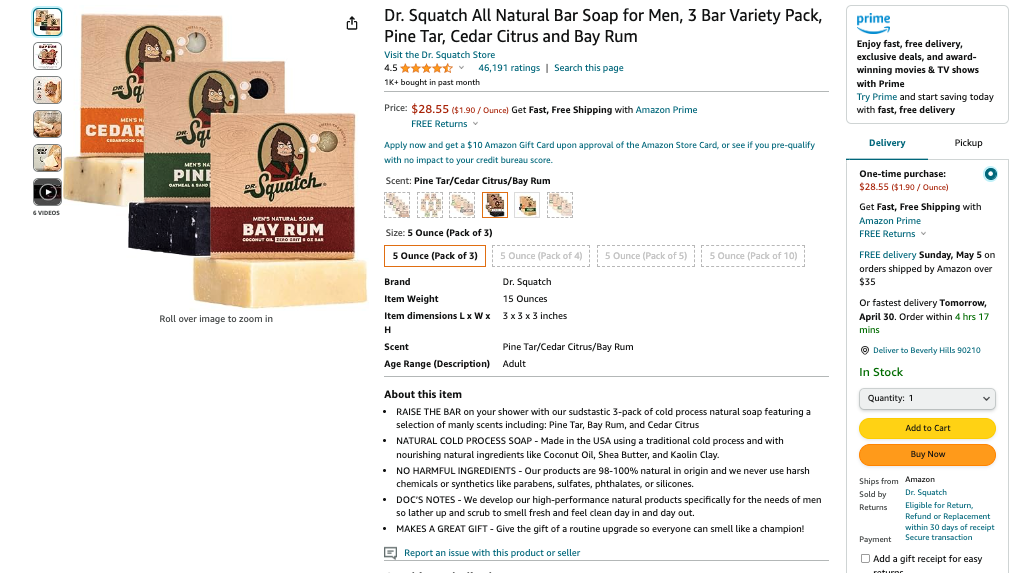
But this is cheating, because their first month was December, which is always a good month.
Historically, January is the worst month of the year for this brand.

January is the company’s worst month and November is this brand’s 2nd best month. That’s not cheating.
❌ We didn’t have any big sale prices
❌ We didn’t have any influencers or TikTok traffic.
❌ We didn’t have any deals.
There was no fluke, no momentum to rely on; it was all pure strategy.
Today, I’m going to walk you through the CHAIR strategy, which is an acronym. Think of each letter as a pillar of a real chair.
I want you to think of a chair.

Like this office chair from Herman Miller with 5 legs.
Why am I showing you this?
It’s the perfect metaphor for selling on Amazon.
It’s got 5 pillars, that hold it in place, regardless of how much you weigh.
✅ You can knock it hard, and it will stay upright.
❌ If you take 1 leg away, the chair might be wobbly.
❌ If you take away multiple legs, it might fall over.
I get it, getting onto Amazon as a Shopify seller can seem daunting.
Curious to see what it would be like to have a pro do it all for you?
Click the button below and I'll do a no-obligation account review and give you a custom plan to implement.
Amazon has gotten a lot more complicated since I started Advertising back in 2017.

Just look at that screenshot of Garlic Press. The 5th position is where Organic ads start.
Back then, people became overnight millionaires because they figured out that Amazon ads were a game changing opportunity.
Now, they’ve gotten a lot more complex… just ask any Shopify seller who has struggled to add Amazon as a successful sales channel.
✅ Now you can run headline ads.
✅ You can run video ads.
✅ You can focus on retargeting shoppers.
✅ You can advertise on your competitors listing.
✅ You can advertise to specific audiences.
✅ You can exclude specific brands from your ads.
We haven’t even started talking about the fees yet.
✔️ Inbound transportation fees.
✔️ Storage fees.
✔️ Long term storage fees (why is that different??).
✔️ FBA Fees.
✔️ Clawbacks.
It goes on and on! Amazon won’t stop screwing over sellers every chance they get.
It makes it so much harder for brands who are not Amazon native to enter the market.
Let’s be honest, they are usually the ones that should be breaking into Amazon!
✔️They’re not just slapping a label on a pre-designed product.
✔️They’re likely some kind of maverick or category leader.
✔️They’re creators.
✔️They’re innovators.
Is this you? Read on, my fellow entrepreneur.
So aside from screwing over innovative sellers, there are also common errors that they make on their own.
❌Lose control of the buy box to Resellers
❌Lose control of the buy box to counterfeiters
❌Improper Inventory Management
❌Neglect Amazon SEO
❌Overspend on irrelevant PPC terms
❌Treating Amazon like Google with branded terms
❌Think Amazon shoppers want same items as Shopify
❌Weak Review Generation
These mistakes sound familiar?
Don’t worry, we will address each of them in the CHAIR strategy.
The more I talk about it, the more I feel bad for brands trying to replicate their Shopify success on Amazon.
SIgn up for a obligation Account Review if you want to see if we can help you fix these problems!

This is going to sound so simple, but in my experience, I’d bet 94% of Amazon agencies aren’t doing this for the brands they manage.
CHAIR stands for:
Let’s dive in!
There are 2 types of Competition that we need to address, Keyword and Buybox.
Keyword competition are other competitors in the Search Results.
Think Google.
Buybox competition is like playing musical chairs with a bunch of kids.
Even though you’re bigger, there’s a chance you will still lose the chair.

There are so many ways you can do this, including using 3rd party tools, as well as Amazon data. I want to give you something basic.
What do you call your products? Just write down the generic names for them. Even if they are in a “category of 1” just think about some other ways to describe your product.
Can’t think of anything? Search your brand name in Amazon and look for the copycats. Then read their titles.
I’ll give you an example, “remarkable” is a category of 1, because they sell notebooks you can write in without ever using paper.

But if you scroll down the search results you’ll see competitor listings that have “digital notebook” in the title.
If you search “digital notebook” on Amazon, it’s a brand new category. Sure Remarkable is at the top, but there is Rocketbook, as well as a bunch of other competitors.

Great, so you’ve told me where all my knockoffs are hiding. So what?
So start analyzing your competition. Where do you beat them?
Surely not price. But what do you have that they don’t?
Better design? Better product? Better packaging? Better value prop?
Most of the time it is all of these. So if those are what are your strengths, then make sure that your listings sell those strengths.
Remember, we are going to be advertising and trying to rank on these keywords, so this is something that is worth doing well.

This is one of the most common issues that Shopify brands face.
Why? Because the idea that someone else could sell on your listing is preposterous.
Don’t I own the buy box on Amazon?
You don’t own the buy box, you’re simply renting it!
You’re currently the most qualified company to sell this product, until a reseller comes along to under-cut you.
The easiest way to check if you are getting beaten up by resellers is to look and see if they are selling your products on your detail page on Amazon.

If you are losing the buy box you need to determine:
❓Where are they getting the product?
❓Is it a legitimate product?
❓Are they undercutting your price?
❓If yes, how are they able to afford this?
❓Are they doing this with FBA fees on Prime?
If you’re not sure, and you already sell on Amazon go to:
Business Reports > Sales and traffic > By ASIN > Detail Page Sales And Traffic
Look for the column “Featured Offer Percentage.”
If it’s below 70%, you’re getting the buy box stolen.

This screen should tell you exactly what you need to know.
If you don’t have a high enough buybox percentage, then you can’t possibly sell enough product.
Here are your options:
All the other options are innefective or un-pallateable, so we are going to focus on Amazon Specific SKUs

This is exactly what Dr Squatch does. It’s also what Costco Does.
Look for a way to unbundle or bundle your product and create a unique UPC.
Maybe only sell 3 packs on Amazon, just like Dr Squatch.
Then slowly transition to only selling that SKU on Amazon.
Once the listing has been built up, remove all other variations of this product.
The others products will still live on the Amazon Catalog, but they will lose all their momentum.
You effectively kill the demand side of the equation by removing the product resellers are selling.
Competition is Amazon’s key to success.
As a Shopify seller, you’re not used to this, because you control your entire website.
Then make sure you keep control of your buy box, so you continue to be the beneficiary of your profits.
SIgn up for a obligation Account Review if you want to see if we can help you dominate your competition!

You want to think about your products, and consider how they will perform in a marketplace instead of just on your website.
Remember, we are now trying to sell our products while there is competition.
Use whatever you learned from the competition analysis to understand which of your products are likely to perform the best.
If you already have products up on Amazon, take a look at your catalog performance. Don’t look at it and just say “what has demand?”
Ask yourself “what has historically been a high performer?”
Even if it’s not your desired product, or it’s not your flagship product.
Spend as much time as you can figuring out what is working on Amazon for your brand.
Try to figure out why it is working as well, because in the next section, we are going to put it on steroids.
If you uncovered products that don’t work on Amazon, either due to keyword or buybox competition, this is your time to fix that.
How can you either bundle or unbundle to get your product price closer to the KW average?
Can you remove features? Can you add features?

This is a great example of unbundling your product to reach a desired price point for a keyword.
Sure they sell more products. They also sell more expensive products.
But for this keyword, they are advertising a cost-effective product, that meets shoppers where they are.
Shoppers don’t want to spend $150 all at once on Amazon.
They’d rather buy something small to start.
Use this as an opportunity to fight back!
What about the buybox? Are you getting hijacked?
Remember Dr Squatch? They’re not getting hijacked, because they made an Amazon specific SKU.

If yes, what can you do to make an Amazon specific SKU?
If that doesn’t make sense for your business, investigate transparency! Or start sending out cease and desist letters.
Just do something. Doing nothing is a great way to let your Amazon business crater.
SIgn up for a obligation Account Review if you want to see if we can help you!

OK, so this is the part where we put what is working on steroids, metaphorically speaking.
This is also the part where Shopify media buyers generally get confused
❓Why does Amazon use ACOS instead of ROAS?
❓Why are there different bidding strategies?
❓Why do Amazon’s Reps give me terrible suggestions?
SIgn up for a obligation Account Review and get a clear plan of how to succeed with Amazon Ads!
❓Why does Amazon use ACOS instead of ROAS?
❓Why are there different bidding strategies?
❓Why do Amazon’s Reps give me terrible suggestions?
All valid questions. The answer?
Read this quote from Geekwire and tell me what you think:

In fact, they are incentivized to drive up spending as much as possible.
That’s the key takeaway from this entire playbook section.
So we will use something called the OSF strategy.
✅Organize
✅Separate
✅Find

You need to give everything a consistent name, and a consistent home. We do this by product.
The Organization formula is
☑️ 1 Parent product per portfolio
☑️ 1 Parent Product per campaign
☑️ 1 Campaign per purpose
☑️ 1 Ad Group per campaign
☑️ 1 Match type per ad group
☑️ As few keywords as possible per ad group
Then rename your existing campaigns in a consistent format that makes them easy to search.
Use something like Purpose of campaign – Product Name – Parent ASIN.
This turns into Auto – Garlic Press – B00000001
If you come across anything that can’t be organized, leave it for step 2, where you will separate them.

So now, we need to separate everything that couldn’t be easily organized.
Luckily, I’ve done this probably 1 hundred times, so I’ve seen all the common problems.
Multiple Parent Product per campaign?
Look at lifetime performance, and then year to date and last 30 days performance.
Is there 1 parent product that is winning?
Great, that is the new parent product of this campaign.
Pause the other product(s) in this campaign.
Also duplicate the campaign for the other product(s) so that every product that was showing can have a campaign like this.
Figure out which purpose was driving the best results.
Branded spend doing best?
Make it a branded campaign and pause all non-branded keywords.
Exact match non-branded terms doing well? Use that instead.
Duplicate the campaign, for every other purpose and then create the campaign for that purpose.
Make sure you pause all the keywords that were related to the purposes.
Multiple Ad Groups per Campaign?
Look at historical performance on the different ad groups and choose the one that is doing best.
Duplicate the campaign and then only run the other ad group.
You know where this is going.
Compare the match types and leave only the best match type.
Duplicating is optional for this step, but can be effective.
Lots of low hanging fruit.
Set to lifetime and see if there are any keywords with:
⏸️ No impressions
⏸️ No clicks
⏸️ No sales
Pause all those.
Still have more?
⏸️ Bad lifetime ACOS
⏸️ Irrelevant keywords
⏸️ Duplicate Keywords
Once you’ve gone through all the separation, make sure you organize the new campaigns you’ve performed surgery one.
Just go back to step 1 and do that. It should make your life easy.

Ideally, non-branded. We will create new single keyword campaigns (SKWCs) for them.
We are doing this because now we are going to be able to isolate our keywords, and then tweak placement.
This is one of the easiest and fastest ways to grow your sales on Amazon.
The steps to do this are simple.
🔍 Look at a long range search term report, ideally 60 days, but you can go shorter if you want.
🔍 Are there winning search terms from a campaign that had a single product?
🔍 Do any of those search terms appear in the Search Query Performance (SQP) report with high search or sales volume?

Even if you’re primarily making sales only on your branded terms right now, there are likely still golden nuggets floating around that we can capitalize on.
Once you’ve found all your keywords start opening the keywords 1 by 1 on Amazon.
What we are looking for here is to see where we are most competitive, not just from a conversion rate perspective, but also from a product strategy perspective.
Then, highlight your top keywords for each product.
✅Put them in your title.
✅ Put them in your bullet points.
✅ Create single keyword campaigns.
✅ Put them in your infographics on your products page.
We want to find the keywords that work for us, and then double down on them, to try to grow our market share.
Have you slapped your forehead yet? It’s crazy how simple this is, but it’s harder in practice.
SIgn up for a obligation Account Review and get a clear plan of how to succeed on Amazon!

Welcome to the Champagne problems section of selling on Amazon.
This is a common issue for Shopify sellers, because they are not used to having to play by anyone else’s rules.
📦 You don’t just need to have adequate inventory.
📦 You need buffer stock as well.
📦 Then, once you have it, you need to sustain it.
There’s a concept called GEO ranking, which dictates that depending on stock availability, one product shows up higher or lower than its competition in the search results.
Better GEO rank across the entire place you’re selling, better sales levels, and lower cost per sale, because of the increase in sales from Organic search.
This is an odd concept to think about, so let’s make it a little more concrete.
Here is a map of the USA.

Look at how big this place is.
Now, if you live in one of these urban areas and you are an Amazon Prime Member, there is a good chance that you can get 2 day, 1 day, or even Same day shipping.
✅ Same Day and Next Day Shipping is standard for most people in most of the US.
So how do they do that? Simple, by having inventory in every area.
You can check by using the Inventory Ledger report inside of Amazon Seller Central.
It shows you where all of your inventory lives, and it is surprising to say the least.
So if you need your inventory to be spread out, then that means you need lots of inventory.
More than you’d think. That’s where this buffer idea comes from.
Further to that point, we also need to keep it up. How? By treating this as a recurring optimization task.

✅Open Seller Central and go to Reports > Fulfillment.
✅Open up your Restock Inventory report.
✅Review Amazon’s Recommendations. Is it surprising?
Do you even have that much inventory to send? If yes, round up to the nearest case pack, then send it.
If Amazon is saying you should send in more than you expect, there is usually a good reason for it.
They might be forecasting an increase in demand. Your ads might be working well now.
As long as you have the inventory and it’s not going to ruin any of your other channels to send it in to Amazon, send the recommended quantities.
Just don’t be too dogmatic about it. Amazon is wrong all the time.
I know that contradicts what I just said, but remember, Amazon has limited incentive to do the right thing, so you need to think about it from your point of view.
If the recommendations are 3x what to expect, consider sending in half.
Remember, we are going to do this again next week. So we are not going to make any sudden moves.

Don’t forget to forecast for what Amazon calls “flagpole days”.
📦Prime Day
📦Black Friday
📦Cyber Monday.
They all see a huge increase in sales, especially if you use them right. So make sure you have stock coverage for those.
Going out of stock during a flagpole event, or just after one, is a cardinal sin of selling on Amazon.
We avoid it by putting dedicated time in our calendar to make sure we are caring for this aspect of our business every day.

Another Champagne problem for your brand.
I need more people to talk about how great my product is.
Step one, create a great product. However, if you have a thriving Shopify store, then you almost definitely already have one.
So assuming you’ve got a great product, how do you get reviews to prove it?
Sign up below to talk to us about how we can do it for you

This is a sanctioned “pay for reviews” program from Amazon.
You pay Amazon Money + give away the units for free, and pay Amazon’s fees as if you sold the units normally.
Then, Amazon finds buyers who will review the product in an unbiased manner.
The problem that most Shopify sellers face is that the reviews are almost always “this is a great product, but it’s overpriced.”
If you are rolling your eyes right now, it’s because this already happened to you.
Amazon shoppers are fickle, especially vine reviewers.
They hate when products are not priced in line with the market.
So you can use this, but when you launch on Amazon, you might want to have a sale price that is in line with the regular price in the market, if you plan on using Vine.
If cutting your price temporarily is not an option, then this might not be a good idea for you.

One advantage you have over your Amazon competitors is that you actually built a brand.
That is a real asset.
One feature that comes with owning a brand is loyal customers.
✅People who buy your products pre-launch
✅People who reply to your newsletters.
✅People who make repeat orders
Tell those people you’re launching on Amazon.
Give them a small discount.
Follow up with them and ask if they’d be willing to leave an honest review.
This is within Amazon’s terms of service, and is something that you could do easily, that your competitors cannot.
Don’t do any of the following for getting reviews:
Basically, you can ask for a review, but it needs to be neutral and not in exchange for anything.

There is a button for review requests on the order page for every Amazon order.
However, it takes a long time to go through and manually request each review.
Plus it’s a boring task.
What you can do instead is pay for any number of software tools that will automatically do this for you.
This is great because it is a set it and forget it feature.
Once it’s done, you never think about it again.
These steps are a good starting point, but without expert knowledge, it’s very easy to unknowingly leave money on the table – but I can do it all for you.
I have spent the last 7 years dedicating my life to selling on Amazon, and I still am constantly surprised by the Amazon marketplace.
Following the steps I laid out above should absolutely drive some results for you, but the biggest opportunities are in the nuance.
✅Competition: Analyze your Competition.
✅ Holistic Product Strategy: Create a Holistic Product Strategy
✅Advertising: Run world class Amazon Ads
✅Inventory: Manage your Inventory like a pro.
✅Reviews: Generate Reviews to create a positive feedback loop.
Simple, but effective, but that’s the point.
Feeling overwhelmed by Amazon’s complex metrics or strict inventory rules?
Tired of agencies that only add to the confusion?
We’re here to change that.
Before we even start to work together, we go through your account and put together a clear actionable plan for success on Amazon.
We seamlessly integrate with your team, enhancing your systems and grow your sales
Our straightforward communication via a dedicated Slack channel ensures you’re always in the loop.
We charge a monthly retainer and a percentage of net profits, so our incentives are tied to your success, short and long term.
Ready to transform your Amazon strategy with a partner who truly shares your goals?
We’re not a hard sale kind of agency.
We have a small number of clients with very low turn over.
✅ If you’re a fit, we’d love to talk to you.
✅ Not a fit? Get a free plan how to succeed on Amazon.
Want to do this but don’t have the time? Hire our world class team to do it for you. |